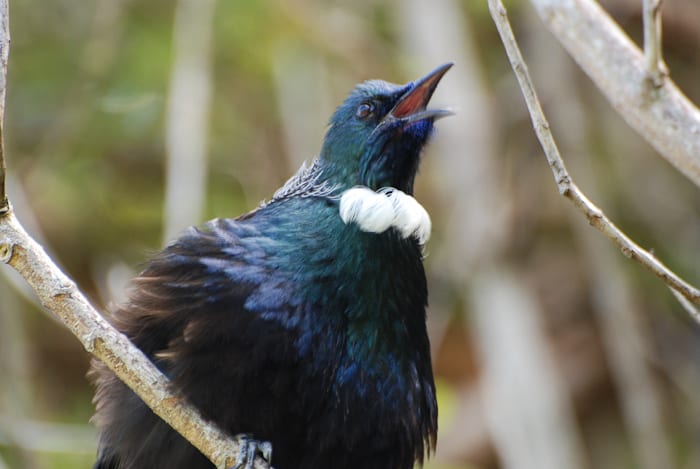One of our common local natives is the Tui. Its highly sheened blue, almost green plumage, signature white throat feathers, which incidentally gives it the occasional name of Parson Bird and rounded out with fine filigree white feathers almost like a lace shawl over black shoulders makes Tui quite easily identified.
Tui are superb songsters and excellent mimics, apparently equipped with double larynx. Often hard to distinguish from Bellbirds, generally the song phrases are somewhat longer. But even so I am from time to time fooled by these two birds. I remember once watching video of a hand reared bird being interviewed. The Tui wasn’t as good a conversationalist but sounded uncannaly like the aviary owner.

Their upper frequency range is far above my ability to hear, and I’ll often see a bird in full song, but quite inaudible . Then it will drop a couple of octaves and all will be revealed.
Tui are, like several New Zealand species quite omniverous, taking nectar, fruit and insects. They have the typically feathered tongue of nectar feeders and the curve of the beak exactly mimics the curve of the local flax blooms. The tongue when extended appears almost double the apparent mandible length.
[flowplayer src=’https://focusingonwildlife.com/news/wp-content/uploads/2012/05/web-video-lead-in.mp4′ width=640 height=480 splashend=show splash=’https://focusingonwildlife.com/news/wp-content/uploads/2012/05/IMG_1984.jpg’ autoplay=false]
They are also extremelyaggressiveand will actively chase other birds away from a preferred food source. This agression will extend even to Kaka (see previous post) who are several times larger and equipped with quite fearson beak and claws.
I have worked with a researcher studying Tui distribution for her doctorate and she told me that the throat tuft has no known purpose. As an adjunct to her studies she was counting the feathers of the males to see if there was any correlation with size. Males arenoticeablybigger than the females.
Peter Tait
Peter Tait is a professional nature guide based at Stewart Island, New Zealand, and he works primarily on Ulva Island Open Sanctuary. Peter has been resident on the Island for over 40 years and was one time Forest Ranger in Charge of Stewart Island. Fishing followed forestry and was in turn followed by Talisker, a 17m charter yacht. He is qualified Skipper Deep Sea Fishing Vessel. In addition to guiding Peter and his wife Iris are hosts at Sails Ashore Lodge.

Leave a Reply